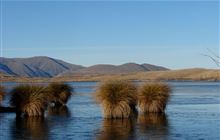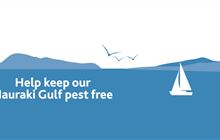Ecological restoration of offshore islands
Introduction
Island restoration aims to rebuild communities of native plants and animals.They are most likely those affected by habitat destruction or invasive species. The rebuilding process can take many decades.
Why restoration is possible on islands
The water that surrounds islands acts as a moat, keeping threats away. Pest mammals can be permanently removed (eradicated) if the islands are too far from each other, or from the mainland for the animals to swim between.
The first attempts at eradication were against larger animals such as wild cattle, pigs, goats and cats. More recently, the smaller species, including mice and three species of rats have successfully been cleared from numerous islands.
Pest eradication
All introduced pest mammals have now been eradicated from over 100 offshore islands around New Zealand.
The largest project completed was the successful removal of Norway rats in 2001 from Campbell Island (11 000 ha), which is part of the New Zealand Subantarctic Islands World Heritage site. The world’s most complex project was the eradication of nine species of pest mammals completed in 2009 on Rangitoto and Motutapu Islands.
These successes provide many opportunities for conservation, and have been responsible for improving the threat status of some species.
Successful eradications are also important because:
- They reduce the chance that pests will spread to new islands where they have never previously been.
- They provide islands where threatened species of plants and animals can return to their former abundance.
- They enable ecological restoration on islands either by DOC, or in partnership with iwi, community groups and private landowners. Examples of these partnerships include Tiritiri Matangi and Ahuahu-Great Mercury.
Planning for successful restoration
For restoration to be successful, it needs to be carefully planned.
Potential problems include competition by aggressive species that take all available food or nest sites. We often need to have detailed information about the species being returned to an island. See examples of restoration plans for the Marotere Islands, Korapuki Island and Mana Island.
We also need to understand how problem species might respond once browsers or predators are removed. On some islands, weeds spread rapidly when farm animals were removed.
The most important part of the plan is to ensure that pest species do not find their way back to islands. We may restrict visitor numbers to islands, and carry out biosecurity checks to make sure visitors clean their gear, check for stowaways, and store food in rodent-proof containers. See examples on the Treasure Islands campaign.
The 'R's of island restoration
There are three key components of island restoration:
- reappearance
- reintroduction
- rehabilitation
Reappearance
A few species of animals were reduced to such low numbers by pests on islands, they were undetectable and only reappeared some time after problem animals were removed. The most famous example of this is the discovery of New Zealand storm petrels nesting on Little Barrier Island (Hauturu-o-Toi) ten years after the eradication of Pacific rats (kiore).
Reintroduction
The movement of plants or animals by people is call translocation. One form of translocation is reintroduction, which is the return of animals to places in their original range.
The first attempted translocations were made by Richard Henry in the late nineteenth century. Newly introduced predators (especially stoats) had spread through the South Island threatening native birds. Henry caught hundreds of kiwi and kākāpō and shifted them to Resolution Island in Fiordland. Unfortunately, stoats swam to the island, so these first attempted relocations failed.
More recently, kākāpō threatened by wild cats were removed from Stewart Island and relocated to Maud, Codfish and Little Barrier (Hauturu-o-Toi) Islands.
Many species have now been reintroduced to islands. Some spectacular examples include Mercury Islands tusked weta, a critically endangered species once reduced in range to one tiny island. The species is now thriving on other Mercury Islands after the removal of rats and rabbits in the 1990s. Another is the robust skink, which is one of New Zealand’s largest lizards. This species is now established on several islands after pest removal. One of the bird species reintroduced to many islands is the saddleback or tieke. The species is now abundant on Little Barrier Island (Hauturu-o-Toi), but had to be reintroduced after the entire population was wiped out by cats.
Rehabilitation
Many species, particularly of plants, are able to spread naturally to islands, a process known as colonisation. Seabirds are also capable of spreading in this way.
After the removal of cats and rats from Raoul Island in the Kermadec Islands in 2006, red-crowned kakariki rapidly recolonised by neighbouring islets as the seabirds such as Kermadec petrels, black-winged petrels and wedge-tailed shearwaters. After the removal of rats from Campbell Island, similar recolonisation soon followed when a rare species of snipe flew from a tiny refuge island nearby.
Rehabilitation is a way for some species to naturally return to their former abundance on islands without the help of people.
Why restoration on islands is important
Importance to conservation
DOC aims to restore species within their ecosystems as part of the New Zealand Biodiversity Strategy. Often restoration on one island will provide solutions for several threatened species at once.
Importance to science
Our islands are unique in many ways. For example, they have many burrowing sea birds and reptiles not found elsewhere. Studies of how they recover when browsers or predators are removed can tell us much about island systems. Island restoration can also provide opportunities to study how introduced species affect native ones because islands often have fewer complicating factors than the mainland. For example, the removal of Pacific rats from some islands is providing the first detailed information on how rats affect birds, lizards, insects and plants.
Most ecological theories used in New Zealand conservation were developed overseas. Some ideas have never been tested in the wild. Restoration provides a rare opportunity to test theories such as whether small populations of animals or plants can survive for long periods in isolation. There are now detailed accounts of the history of pest eradications on New Zealand islands, and how the understanding of the restoration processes has developed.
Importance to island’s native biological inhabitants
Island restoration of islands is not just of benefit to threatened species. Many others, common on islands, but now absent or rare on the mainland, benefit from the absence of introduced predators and the wide range of habitats and food species that restoration can provide.
Importance of the islands to people
DOC and the scientific community are not the only people to benefit from island restoration.
On islands where the public can visit and participate in restoration, they can help gather information about the way habitats and species abundances change over time. Tangata whenua (Māori) are increasingly developing partnerships DOC for island management – and to reestablish cultural links with the motu (islands). One such example is on Moutohora Island, another is with Project Island Song.
By being involved in these projects, New Zealanders will see plants and animals rarely found elsewhere. They can also use these experiences to understand how pests have modified environments on the three mainland islands.
Most importantly, the spectacular changes seen on many restoration islands demonstrate why we need to ensure that pest species are not spread to islands around New Zealand.
Our role
DOC, community groups, schools, plus Māori and private landowners are all involved in restoration projects. Many restoration islands are Nature Reserves with limited public access.
But there are now many restoration projects on islands open to the public as open sanctuaries. Most of these are accessible by ferry or water taxi.
You can visit some of the islands and participate in projects there.




